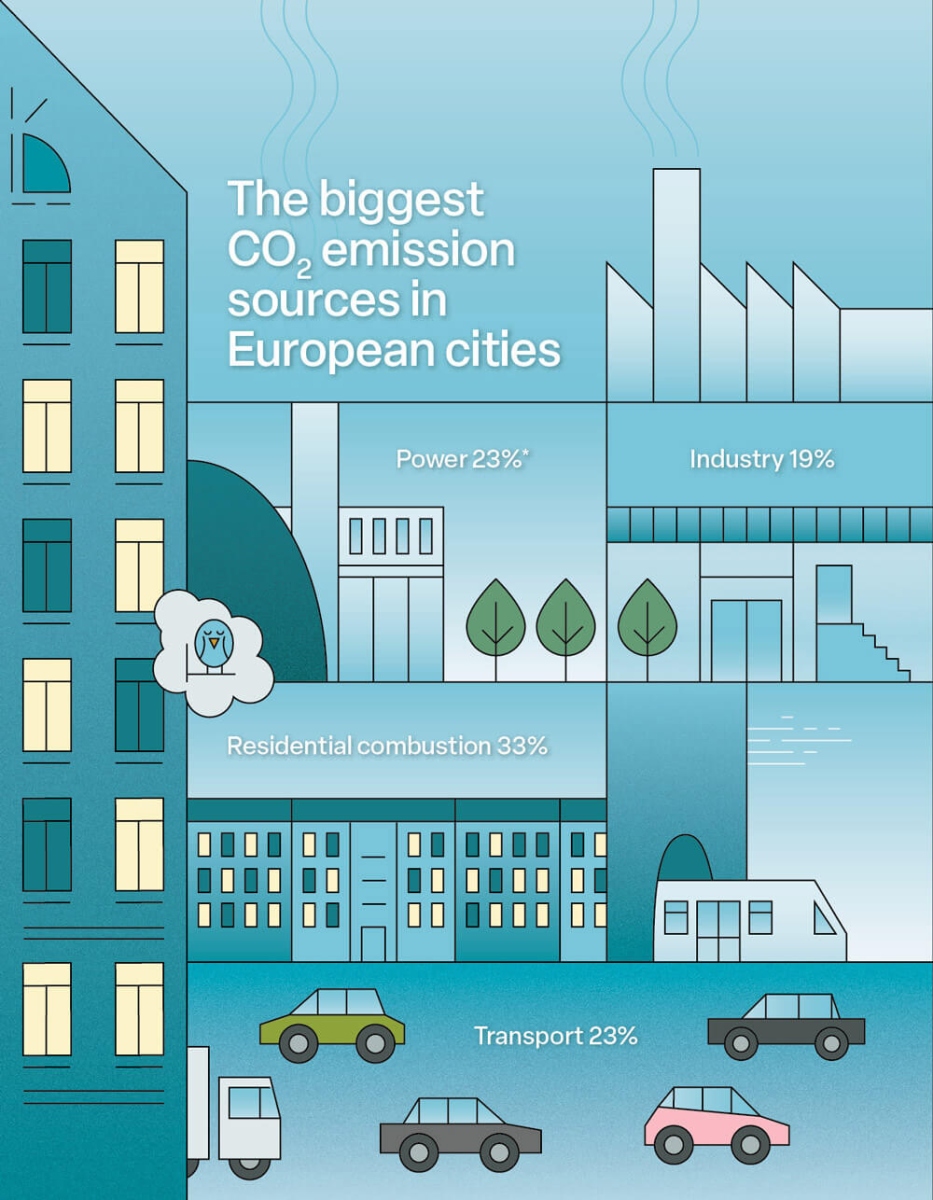Cities emit a large amount of greenhouse gases, but they also hold significant potential to mitigate the climate crisis. While national governments set ambitious climate targets, cities are where policies turn into tangible action.
Key takeaways
- Cities turn policy into action. While national governments set broad climate targets, cities are where policies become tangible solutions, influencing infrastructure and citizen behavior.
- Cities are hubs for effective change. Their concentration of people and resources allows for the efficient implementation of sustainable solutions, which can drastically reduce per capita emissions.
- Data is crucial for success. To ensure their investments are effective, cities must use accurate data to monitor emissions and track progress.
The world is rapidly urbanising, with nearly 70% of the global population expected to live in cities by 2050. Despite covering only 3% of Earth’s land, urban areas are significant contributors to climate change, consuming over 75% of global resources and generating up to two-thirds of global carbon dioxide emissions, according to the UN’s Intergovernmental Panel on Climate Change (IPCC).
“Accelerating decarbonisation in cities is crucial because they concentrate population, economic activities, and infrastructure that can either lock us into high-carbon pathways or lead the transition to sustain- ability,” explains Professor Bart van den Hurk, Co-Chair of Working Group II on impacts, adaptation, and vulnerability at the IPCC.
Mitigation and adaptation, he notes, can and should go hand-in-hand, and cities can achieve this by changing their infrastructure and governance as well as supporting behavioural shifts.
Cities are also critical actors in sustainable transformation; while national governments establish broad climate targets and policy, the real impact often stems from implementation at the urban level.
"Cities can be powerful influencers – they have control over their own operations and infrastructure services,” says Professor Kevin Gurney, an atmospheric scientist, ecologist, and policy expert at the Northern Arizona University.
Cities can be powerful influencers – they have control over their own operations and infrastructure services.
Professor Kevin Gurney - Atmospheric scientist, ecologist, and policy expert at the Northern Arizona University
He adds that, due to the concentration of people, cities are where “a lot of social norms can be developed – and behaviour and social norms are a big piece of the puzzle”.
Emilio Servera, Project Officer at València Clima i Energia, Spain, agrees: “Local authorities engage directly with citizens. We are the first point of contact, we understand our citizens’ needs better than other levels of government, and that makes it easier to implement climate projects.”
In this way, cities can become innovation hubs with the potential to lead climate action. Many are already demonstrating this and making significant strides towards decarbonisation by investing in renewable energy, improving public transport, adopting green building standards, and working on green urban planning.
If scaled up, these efforts could play a pivotal role in decreasing emissions even as urban populations continue to grow.

Climate-smart growth and resource efficiency
With more than 2.5 billion people living in urban areas by 2050, a significant increase in greenhouse gas emissions is expected due to higher energy consumption, increased transportation, new building construction, greater waste generation, and expanded industrial activity.
One significant hurdle for megacities – those sprawling urban centres with populations exceeding 10 million – is the phenomenon of ‘emissions lock-in’. Once infrastructure decisions are made, they become incredibly difficult and costly to reverse, effectively cementing a city’s carbon footprint for decades.
However, rapidly expanding urban areas stand at a unique crossroads, possessing the crucial opportunity to embrace sustainable practices and infrastructure. On a global level, medium-sized cities are projected to see the most growth. This is where Professor Gurney sees the greatest potential for climate-smart solutions:
“Cities that are on the cusp of growing a lot have the opportunity to grow differently, unlike megacities that have really gotten to the point of emissions lock-in. That’s where the biggest opportunities are. The medium-sized cities can take a very different path.”
For instance, compact, walkable cities with good public transport systems have been shown to reduce per capita emissions compared to sprawling, car-dependent cities that lead to high-carbon lifestyles.
However, emissions can still be high in compact cities if the energy supply is fossil-based or if consumption patterns are resource-intensive, which shows the need for a holistic approach that addresses all sectors.
Influential city networks
Organisations like ICLEI – Local Governments for Sustainability and Eurocities facilitate crucial knowledge sharing and peer-learning between cities.
The following organisations also empower cities in the transition to a sustainable and climate-resilient future:
- The EU Covenant of Mayors: A large-scale initiative that brings together thousands of local and regional authorities across Europe to voluntarily commit to tackling climate change.
- C40 cities: A global network of mayors from cities around the world leading efforts to tackle the climate crisis.
- EU Mission Climate-Neutral and Smart Cities: Originally, 112 pioneering cities were selected to achieve climate neutrality by 2030, acting as innovation hubs for broader urban transformation. As of today, 377 cities from all 27 EU member states have submitted an expression of interest.
- Green City Accord: European mayors are actively participating in this EU initiative, committing to cleaner, healthier, and greener cities.
- WWF One Planet City Challenge: WWF engages with cities worldwide, guiding them to set and achieve ambitious climate targets, while promoting best practices and citizen engagement.
Biggest emission sources: transport and housing
The housing sector accounts for approximately 31% of global CO2 emissions when considering direct emissions, according to the IPCC. Transport is another significant contributor, responsible for about 15% of human-induced global greenhouse gas emissions.
Emissions vary widely, depending on factors like wealth and citizens’ attitudes towards individual versus public transport.
“Many cities lack strong public transport networks, making residents dependent on cars,” says Dr Felix Vogel, Research Scientist at the Environment and Climate Change Canada and a member of the ICOS Cities Scientific Advisory Board.
Many cities lack strong public transport networks, making residents dependent on cars.
Dr Felix Vogel - Research Scientist at the Environment and Climate Change Canada and a member of the ICOS Cities Scientific Advisory Board.
Meanwhile, cities like Paris, London and New York developed subway systems early on, allowing mobility without cars. Cities are also investing in low-emission zones that restrict access for high-emission vehicles, alongside measures to expand cycling and pedestrian networks to cut transport emissions and improve urban resilience.
The concentration of people, money, and infrastructure makes cities the best place to implement resource-efficient systems, including to address sectors with larger emissions, such as buildings.
“Cities are usually more energy-efficient per capita than rural areas. For example, high-rise buildings with centralised heating and cooling systems are much more energy-efficient than single-family homes in the countryside,” Dr Vogel explains.
Indeed, compact, well-planned cities can drastically reduce per capita emissions, according to the IPCC. Public transport investments, for instance, can cut per capita transport emissions by more than half compared to car-dependent cities, reports the Institute for Transportation and Development Policy.
In addition to climate benefits, reducing urban emissions can also improve residents’ well-being. One notable co-benefit is the reduction of air pollution, which is a major health concern in many cities.
By transitioning to cleaner energy sources and improving urban mobility, cities can significantly cut emissions of pollutants, directly improving air quality and benefiting citizens’ health.
Why monitoring urban emissions is critical
As cities strive to reach their climate targets and reduce their impact on the planet, accurate monitoring of emissions is crucial.
“We need to know what’s working and what isn’t. Cities need solid information, with granular and sectoral details to help them prioritise,” says Professor Gurney.
He adds that, while the general steps to lower emissions are known, efficiency is crucial. Cities need to know where, when, and how emissions are occurring to decide the best opportunities for mitigation.
“The point is that, when a city decides to spend money on mitigation, it’s not a question of what the big categories are – it’s more that the actions have to be efficient,” he explains.
Alongside helping with the initial prioritisation of mitigation actions, monitoring provides invaluable feedback and helps cities plan for future low-carbon development.
“Once we have enacted a policy, the second phase is tracking it over time. The sooner I know that it’s not working, or it is working, the better off I am, I can change course. If it’s working just as I thought, I can then reproduce that elsewhere. That feedback loop is crucial,” Professor Gurney concludes.

We need daring cities with daring leaders
While national policies remain critical, local governments are stepping up with ambitious climate targets and innovative solutions. To reverse the trend of rising emissions, daring city leadership is needed.
“We now need daring cities with daring leaders, brave leaders. Our local governments have been setting targets on climate way before the national governments have done so,” says Maryke van Staden, Director at the Carbon Climate Center, ICLEI.
“We see the sub-national governments as leaders in this space. They have helped push to improve national policies that enable action at the local level,” she adds.
This proactive stance is backed by Miranda Schreurs, Professor, Environment and Climate Policy, at the Technical University of Munich and the leader of the ICOS Cities project’s climate policy team.
“A large number of cities have established climate neutrality plans that are well ahead of national targets. These were often adopted after local governments were pressured by their citizens to do more,” she says.
A large number of cities have established climate neutrality plans that are well ahead of national targets.
Professor Miranda Schreurs - Environment and Climate Policy, at the Technical University of Munich and the leader of the ICOS Cities project’s climate policy team
However, while cities are critical for implementation, national policies play a crucial role in enabling or hindering this as local governments do not have jurisdictional competence in all areas, Professor Schreurs explains. This makes national policy frameworks vital.
“National governments can shape policy expectations, mandate policy action, affect energy prices, and influence investment decisions. National governments also need to provide the financial and technical support that cities need for project implementation,” she adds.
Van Staden also highlights the importance of enshrining strategic public sustainable procurement in national policy to drive local action.
“This is an enabling factor that can allow the local government in its whole operations to choose services and goods that are the cleanest, greenest, and with the least impact in terms of emissions.”
Global trends in urban emissions reduction
Urban emission trends vary dramatically across the globe and are influenced by three important factors:
1. Policy & migration
“Globally, city emissions are still going up,” notes Professor Kevin Gurney. “But what is really happening is that the US emission curve is functionally flat, not rising or falling, and Europe has been going down in urban emissions.”
He largely attributes Europe’s downward emission trend to its proactive and forward-looking policy framework, saying that he thinks cities have followed decarbonisation policies very eagerly.
In contrast, Professor Gurney highlights a different trajectory in rapidly developing regions: “In India, China, South Asia, a lot of the emerging economies, urban emissions are still growing.”
The primary cause is not a lack of decarbonisation policies but a steady migration flow to cities. Even with stable or even slightly decreasing per capita emissions the urban emissions would still rise in these regions.
2. Trade
Cities typically ‘outsource’ significant amounts of greenhouse gas emissions to the regions that manufacture their building materials, vehicles, food, and consumer products.
“There’s a lot of carbon leakage where many European and US cities are becoming fundamentally consumerist cities, and they’re consuming from Asia. These regions now have become the sort of ‘production cities’ where emissions go up quicker,” Professor Gurney explains.
Consequently, most European and US cities have a larger carbon footprint than their local, territorial emissions would suggest.
“Even though much of the energy is consumed in cities, not all emissions occur within city boundaries. Also, a lot of energy production happens outside urban centres, in power plants,” says Professor Dominik Brunner at Empa, Swiss Federal Laboratories for Materials Science and Technology.
Even though much of the energy is consumed in cities, not all emissions occur within city boundaries.
Professor Dominik Brunner - Empa, Swiss Federal Laboratories for Materials Science and Technology
If cities don’t consider emissions from the goods they consume or from activities outside their borders, they will significantly underestimate their climate impact, disregarding up to 41% of their emissions.1 By taking into account both direct and indirect emissions, cities can tailor their mitigation strategies to be most effective for their particular city and emissions profile.
3. Population growth
Another critical challenge lies in the demography of developing economies, especially in Africa, where emissions are increasing faster than population growth. While rising emissions are partly driven by Africa’s rapidly growing population, they also stems from escalating energy demand, a continued reliance on fossil fuels, and an increase in private vehicle usage due to poor-quality or lacking public transport.
However, it is also an opportunity for global cooperation. As Professor Brunner argues: “we should do everything possible to help developing regions implement low-emission technologies now before their urban expansion locks them into high-carbon systems”.
City-to-city insights
By Charlotta Henry
Cities have unique strengths and resources for climate action.
1. What unique strengths or resources do cities have for climate action compared to national governments?
2. What kind of external support would help your city improve climate action planning?

1. Local authorities have more direct contact with citizens and small businesses than other levels of government. Being in close proximity to the daily lives of people allows cities to address climate challenges, while ensuring a positive impact for all, including vulnerable groups.
2. The municipality needs human resources and capacity building. There is also a need for support to develop schemes that mobilise and align the funding, commitments, and decarbonisation projects of the private sector, academia, and civil society.

1. Within their limited authority, cities can set and achieve more ambitious targets and invest in pilot actions, from which other cities can profit.
2. For action plans, it is always advantageous if the city, canton, and state are on a similar path. City-wide, Switzerland-wide, Europe-wide, or global networking can help to further consolidate our climate action planning.

1. Cities can act more quickly and flexibly than national governments, adapting policies to local needs. Many cities also own their own energy companies, giving them direct leverage over decarbonisation and renewable energy choices. When it comes to climate adaptation, challenges such as heatwaves, flooding, and urban planning are inherently local, making cities the most effective actors.
2. We need technical expertise and modelling tools to better forecast the impacts of different mitigation and adaptation policy scenarios, tailored to Helsinki’s topography, building stock, transport systems, and climate risks (flooding, heat, sea-level rise).
References
1 IPCC Sixth Assessment Report
